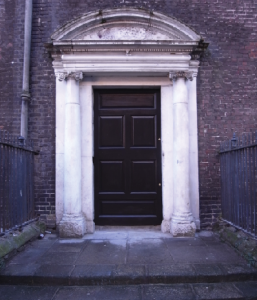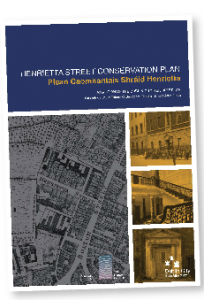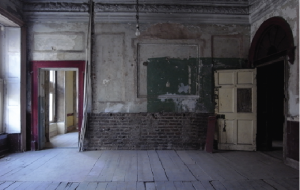Museum eye: The Tenement Experience
Published in 18th-19th Century Social Perspectives, 20th Century Social Perspectives, Issue 4 (July-August 2013), Reviews, Volume 21 The Tenement Experience
The Tenement Experience
14 Henrietta Street, Dublin 1
www.1913committee.ie
by Tony Canavan

The aedicular Ionic doorcase of No.14 Henrietta Street still has a faded grandeur. (C. Duggan/Dublin City Council)
Henrietta Street, off Bolton Street, is one of the oldest surviving streets in Dublin. Most of the houses were built in the 1740s; its proximity to the King’s Inn meant that it was a prestigious address and attracted many from the legal profession to live or establish chambers there. Today it still has a faded grandeur, despite the neglect of some of the houses and the many boarded-up windows. It is also a busy thoroughfare, however, owing to the King’s Inn library at the top of the street beside the impressive arch, which provides access to the King’s Inn and the public park in which it sits.
Number 14 was built in 1748 to what is known as the Burlington plan. Although a terrace house, it had a large entrance hall, reception rooms downstairs and a garden beyond, at the bottom of which were the stables. An ornate staircase led upstairs to the other two storeys, while in the basement was the kitchen and associated rooms. Although the house had wealthy residents for the first century or so of its existence, it has a somewhat chequered history. In the 1860s it was acquired by the government and became the home of the encumbered estates court (an early version of NAMA). After this it was the depot of the Dublin militia and so took its first step to multiple occupancy, as it housed soldiers and their equipment. This phase did not last long, as by the early 1880s it had become a tenement, home to a number of Dublin families. Poor though these people were, they did not occupy the lowest rung of the ladder, as the stables at the rear and the lane leading to them housed the truly wretched.
One notable feature of this tenement period was the religious dichotomy at work. Census returns reveal that the side of the street on which No. 14 stood was occupied mainly by unskilled Catholic tenants, while the other side of the street housed better-off Church of Ireland families. It remained as a tenement well within living memory and was in private ownership right up until recently. By the later years of the twentieth century the house, along with much of the street, was in a sorry state and in danger of collapse. In 2000 Dublin City Council acquired No. 14 and adjoining properties under a compulsory purchase order. Immediate action was taken to secure the building and the council developed a heritage plan for the area.

In 2000 Dublin City Council acquired No. 14 and adjoining properties under a compulsory purchase order. Immediate action was carried out to secure the building and the council developed a heritage plan for the area. (Dublin City Council)
Number 14 is a key element of the plan. The decades of neglect have had the paradoxical consequence of preserving its character as a tenement building and it is intended that that aspect of the house’s history will be central to any future development; the 1913 Lockout in particular will feature strongly. Each phase of the house’s existence has left its mark. Many of the original architectural features remain—such as decorated plasterwork and door surrounds—but over the centuries new walls were included, the grand staircase removed, rooms subdivided and so on. The council does not intend to ‘restore’ the house to any particular period but rather to conserve it more or less as it is, doing only what is necessary to make it secure and preserve its essential character.
This is a major undertaking in itself and is being carried out in conjunction with the Irish Heritage Trust, which will manage the house when it is open to the public. To mark the centenary of the Lockout, the first project will be an immersive visitor experience based on that. The 1913 Lockout Committee, an ICTU initiative, is involved, while Anu Productions will provide the actors for the installation. This company staged Laundry, for example, the second instalment in a series exploring the social history of a quarter-mile area in Dublin’s north inner city in which the public was invited on a challenging, stimulating and thought-provoking journey through the Gloucester Street Magdalene Convent. The 1913 installation will take place over a nine-week period in July and August 2013. Based on the ground floor, the rooms will show the conditions in which people lived then, providing the social, economic and political background of the Lockout.
As No. 14 was a tenement within living memory, there are some artefacts left from that period as well as fixtures and fittings, such as the gas pipes and rugged floorboards. On one wall even a graffito from the 1900s has survived, an unflattering message from one tenant to another. Small groups will be given tours of the installation, going from room to room and encountering characters from a century ago. These people, played by the Anu actors, will convey what life was like and recount actual experiences from that time.
This will be complemented by videos running on screens and information panels. While few or no written records remain of life in the tenements, there are a number of audio and video recordings made in the last century of people recalling their lives in them. As well as this, still photographs, newspapers and official reports all add a further dimension to our knowledge of life and work for Dublin’s poor. There are plans to launch a website that will act as an archive, bringing together the various records relating to tenement Dublin, while those with actual memories or a family tradition of these houses will be invited to contribute to the archive. The long-term objective is to create a permanent ‘Tenement Experience’ at No. 14, specifically aimed at reconnecting with the community around Henrietta Street, as a collaborative endeavour on the part of the three key partners. HI

The stair hall room at first-floor level. The decades of neglect have had the paradoxical consequence of preserving its character as a tenement building. (C. Duggan/Dublin City Council)
















